MicroEcon Chapter 8
1/22
There's no tags or description
Looks like no tags are added yet.
Name | Mastery | Learn | Test | Matching | Spaced |
|---|
No study sessions yet.
23 Terms
Gains from Trade
The benefits that come from reallocating resources, goods, and services to better uses.
The big pictures:
You have some stuff.
Other people have other stuff.
You want some of their stuff more than they do.
They want some of your stuff more than you do
Gains from Trade Example
Airbnb Example: You have an apartment in Chicago. You will be out of town for 2 weeks visiting friends elsewhere.
Another person is visiting Chicago for a few days, and they want a place to stay.
You rent your apartment to them via Airbnb.
For those few days, they want your apartment more than you do, and you want money more than your apartment (for those few days).
Trade your apartment for money and you both become better off
Comparative Advantage
The ability to do a task at a lower opportunity cost
(The opportunity cost of something is what you gave up to get that thing)
How to figure out the comparative advantage
Compare:
What can you produce if assigned one task versus the other?
What can the other person produce if assigned one task versus the other?
And find the Advantage:
If you give up relatively less to get a task done, then it’s more efficient for you to do that task.
You have the advantage
Absolute advantage
The ability to do a task using fewer inputs (including time)
Absolute advantage tells you who is best at a task, but NOT who should do the task
More information of Absolute advantage (EXAMPLE)
You would have an absolute advantage in processing payments if...
You could process 10 payments using fewer inputs (less time) than the other person.
Using the same inputs (same amount of time), you can process more payments than the other person
Balance and Processing Accountant's example for Absolute Advantage
Natalia:
balance an account in 30 minutes.
process a payment in 10 minutes.
Ryan:
balance an account in 40 minutes.
process a payment in 10 minutes.
Natalia can balance an account using fewer inputs (30 minutes v/s 40 minutes).
In an hour Natalia can process more payments (2v/s 1.5).
Natalia has an absolute advantage in balancing payments
How to assess comparative advantage
Create a productivity table
Determine the given productivity
Are Outputs given or Inputs?
Convert this table into a measure of opportunity cost
First find the opportunity cost of each box
IF GIVEN INPUTS
Opp. cost of task X = Quantity of Inputs for Task x/ Qty of Inputs for Tasks Y
(FLIP ORDER OF CONVERSION FOR THE SECOND COLUMN OF TABLE)
EX. Opp. cost of task X = Quantity of Inputs for Task Y/ Qty of Inputs for Tasks X
IF GIVEN OUTPUTS
Opp. Cost of Task X = Quantity of Output for Task Y / Qty of Output for Tasks X (orignal formula)
(FLIP ORDER OF CONVERSION FOR THE SECOND COLUMN OF TABLE)
EX. Opp. cost of task X = Quantity of Output for Task X/ Qty of Inputs for Tasks Y
Evaluate! Who can produce each good at the lowest opportunity cost?
This process identifies who has the comparative advantage in each task!
Ideas in Calculating opportunity cost
Depends
Use productivity expressed in terms of how much input it takes to produce one unit of output.
Use productivity expressed in terms of how much output can be produced with one unit of input
Opportunity Cost Equation for Inputs
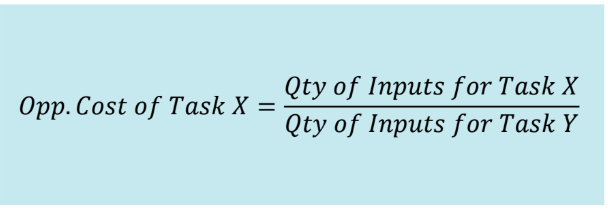
Opportunity Cost Equation for Outputs
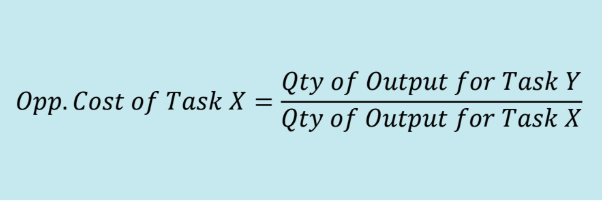
Visual Example of Comparative Advantage Pt.1

Visual Example of Comparative Advantage Pt.2
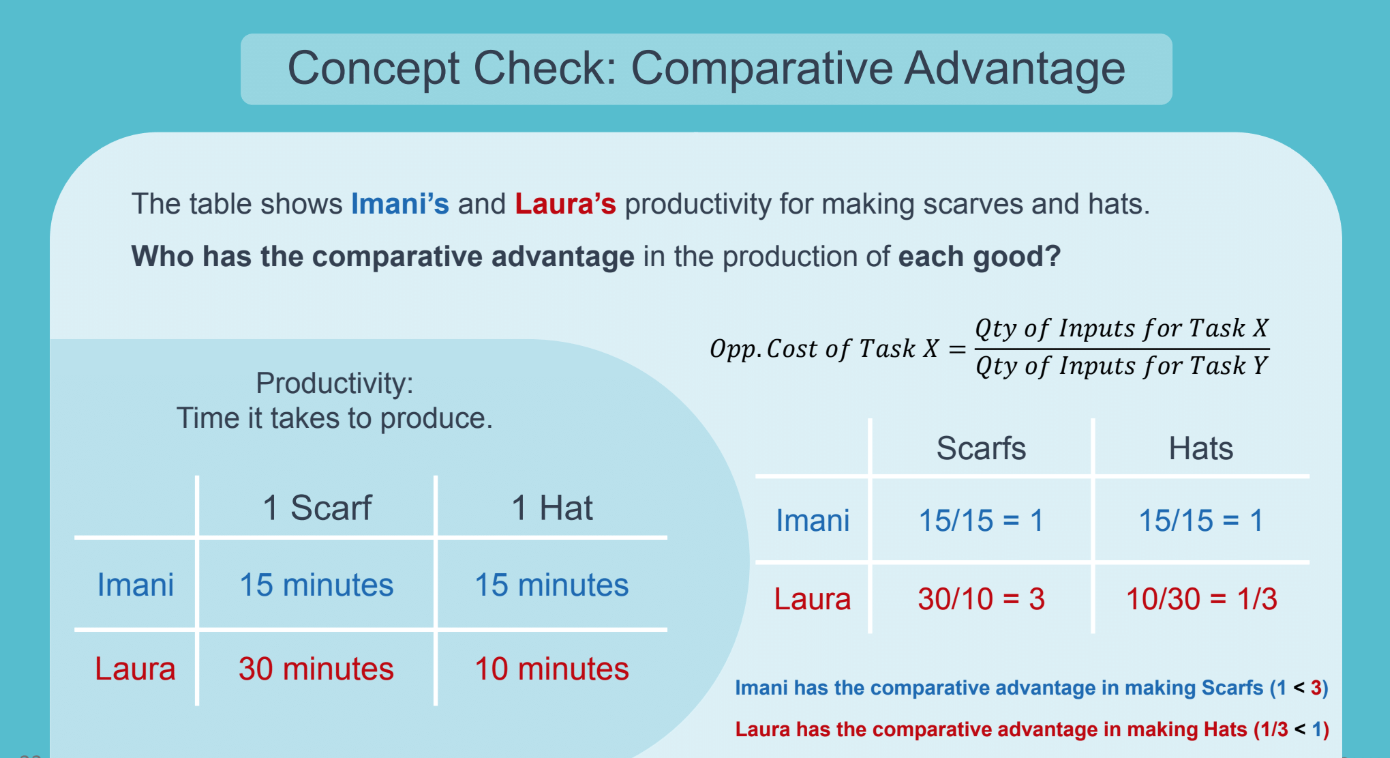
Markets facilitate gains from trade
Markets offer the opportunity to specialize according to comparative advantage:
You specialize in one task and get paid for doing that task.
Other people specialize in other tasks.
Then everyone trades, generating an economic surplus!
Markets facilitate gains from trade Example
Example: You are good with numbers and become an accountant.
You use part of your paycheck for...
car repairs; meal-prep services (think HelloFresh); cleaning services (think Roomba), etc. Markets allow you to trade tasks!
you spend less time doing tasks that you are not relatively good at (where your opportunity cost is high) and more time elsewhere
Comparative advantage drives international trade
We trade with foreigners for the same reason we trade with locals.
You produce what you are relatively good at producing and buy everything else from others.
“Others” might be your neighbor or “others” might live in a different country.
The gains from trade created by comparative advantage are the reason for international trade.
National borders are irrelevant to the central idea that there are gains from trade!
The only difference is that with international trade, goods are called imports and exports.
Trade is simply about minimizing opportunity costs
Specialize and Trade
You should specialize in producing the good for which you have a comparative advantage
Domestic Trade Example
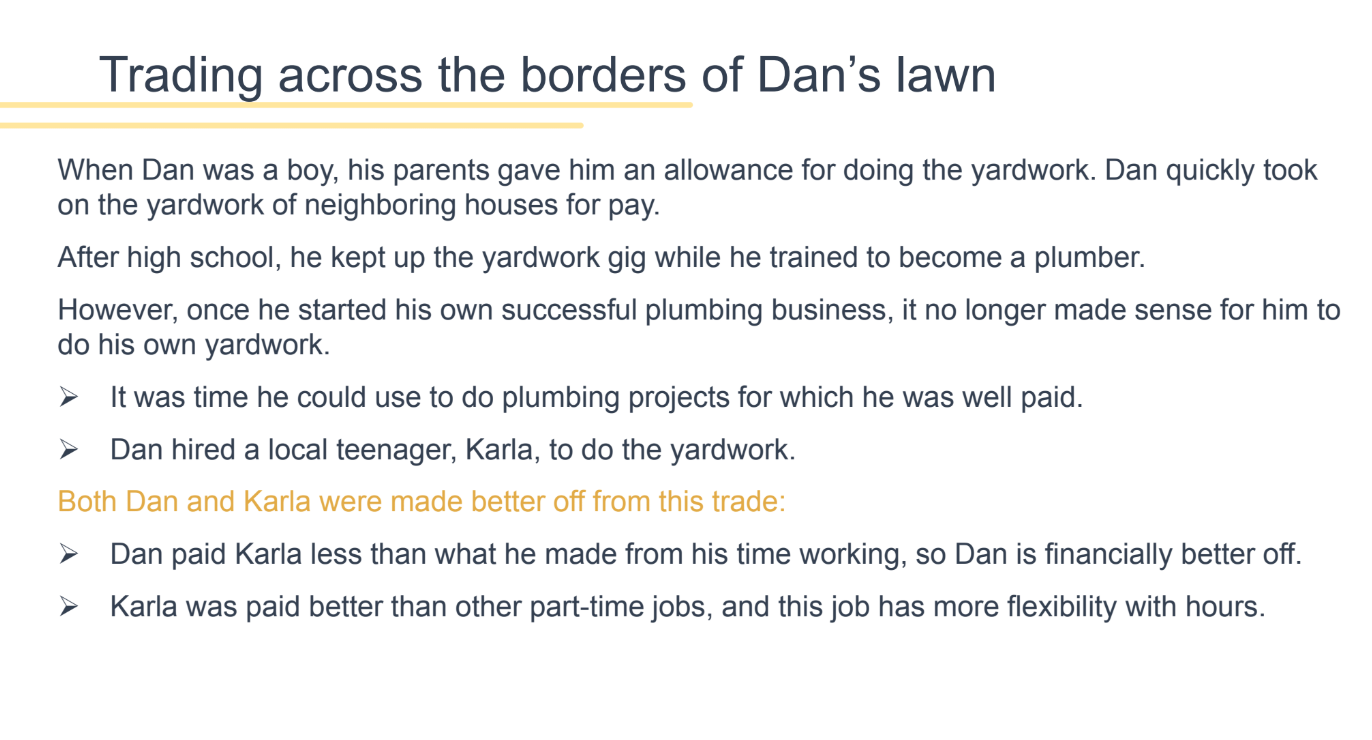
International Trade Example
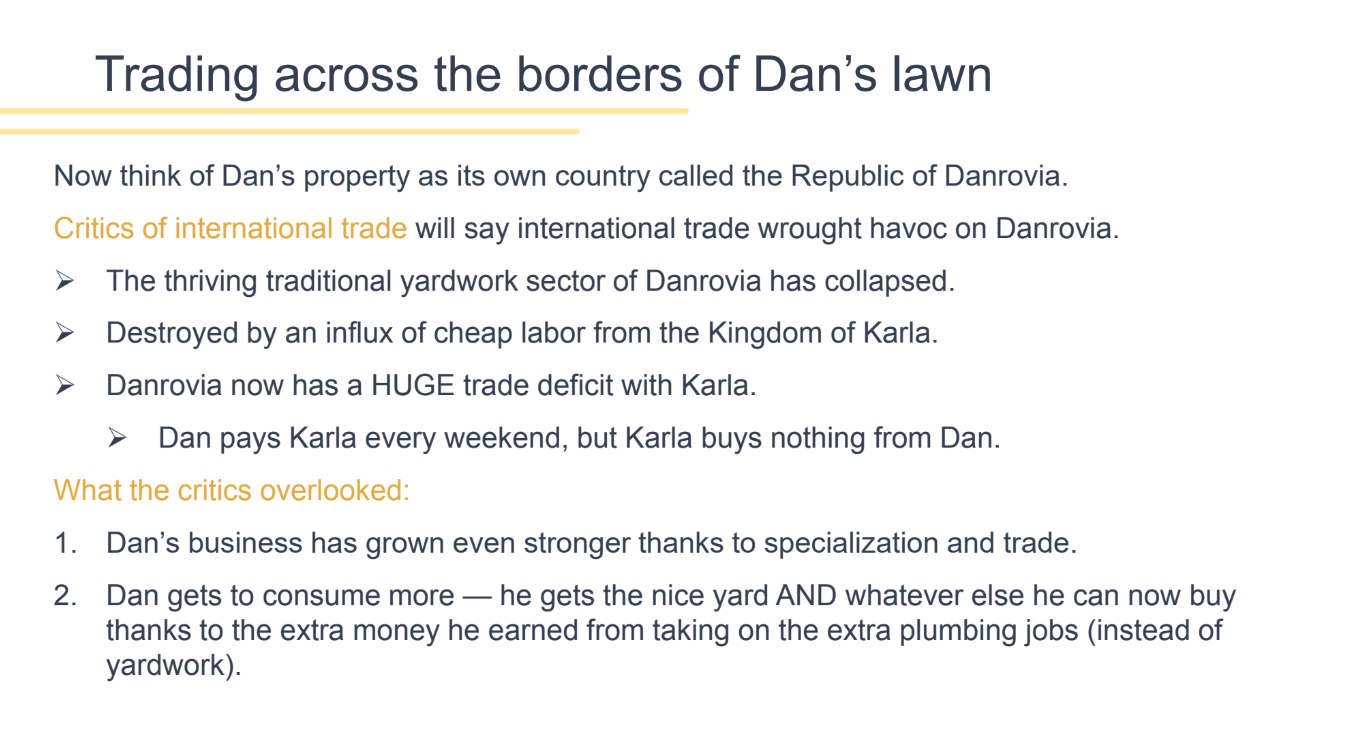
3 ideas of the power of Price
1. Prices are signals
2. Prices as incentives
3. A price aggregates information
Prices are signals
For Buyers
The price is a signal to potential buyers about how expensive it is for sellers to produce more of a product, revealing the seller’s marginal cost.
For Sellers
The price is a signal to potential suppliers about how much buyers value a good (like quinoa!), revealing their marginal benefit.
Prices as incentives
A high price is an incentive for...
sellers to produce more → new profit opportunities!
buyers to buy less → consider switching to an alternative (if available).
strangers to coordinate → buying and selling plans end up balancing out.
A price aggregates information
Prediction markets: Markets whose payoffs are linked to whether an uncertain event occurs.
The process of buying and selling aggregates information about the event.
Sports-betting example: The quarterback gets injured, and this information is reflected in the decline of that team’s odds in the sports-betting market